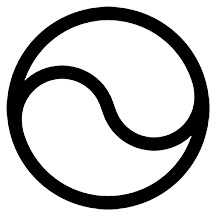 The symbol shown here represents a Hypersphere, sometimes called a three-sphere, or a 4-ball, or an S3 manifold.In such a hypersphere the internal 'diameter' or Antipode length equals half the circumference, making it somewhat 'larger on the inside than on the outside'. Its resemblance to the Taoist yin-yang symbol seems most pleasing, the classical oriental mystics thought of most things at one time or another although not always in simple to understand terms.
The symbol shown here represents a Hypersphere, sometimes called a three-sphere, or a 4-ball, or an S3 manifold.In such a hypersphere the internal 'diameter' or Antipode length equals half the circumference, making it somewhat 'larger on the inside than on the outside'. Its resemblance to the Taoist yin-yang symbol seems most pleasing, the classical oriental mystics thought of most things at one time or another although not always in simple to understand terms.
The Hypersphere Cosmology section of this site now contains several new papers dealing with aspects of the main hypothesis in more mathematical detail and with more detail on the physical principles implied.
Hypershpere Redshift shows the mechanism by which the small positive curvature of the non-expanding universe redshifts light from distant galaxies.
Hypersphere Rotation shows the derivation of the equation for the four-rotation of any hypersphere derived from Godels three-rotation of a simple sphere. Any valid derivation from an exact solution of the field equations of General Relativity presumably has its own exact solution in there somewhere.
Hypersphere Holometry derives from the Beckenstein-Hawking conjecture about the relationship between the information content of a black hole and its surface area. If true, and if applicable to hyperspheres, the conjecture leads to a prediction about the quantisation of space and time which Holometry experiments in progress may validate.
Hypersphere Visualisation and Lensing shows a fairly simple method of visualising what a hypersphere 'looks' like, and the lensing diagrams show how a hypersphere will distort sight lines across the universe creating the optical illusion of an apparent acellerating expansion.
On an entirely different matter Pactionis 2, first presented on a blog here in 2013, reappears in the Wizardry section, because it needs to.